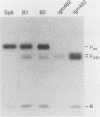Abstract
Mutant hybridoma-myeloma cell lines that are defective in immunoglobulin production are expected to be useful for defining the molecular requirements of immunoglobulin gene expression. The analysis of such mutants would be greatly facilitated if they could be mapped by marker rescue, i.e., by identifying the segments of wild-type DNA that can restore the normal phenotype by homologous recombination with the mutant chromosomal immunoglobulin gene. To assess the feasibility of this type of mapping, we have measured the efficiency with which fragments of wild-type DNA recombine with a mutant hybridoma immunoglobulin gene and restore normal immunoglobulin production. We found that most if not all recombinants were detectable 2 days after DNA transfer and that the frequency of gene restoration increased with increasing length of the transferred mu gene fragments, between 1.2 and 9.5 kilobases. These results indicate that the available technology should be adequate to map mutations in the mu gene to within approximately 1 kilobase.
Full text
PDF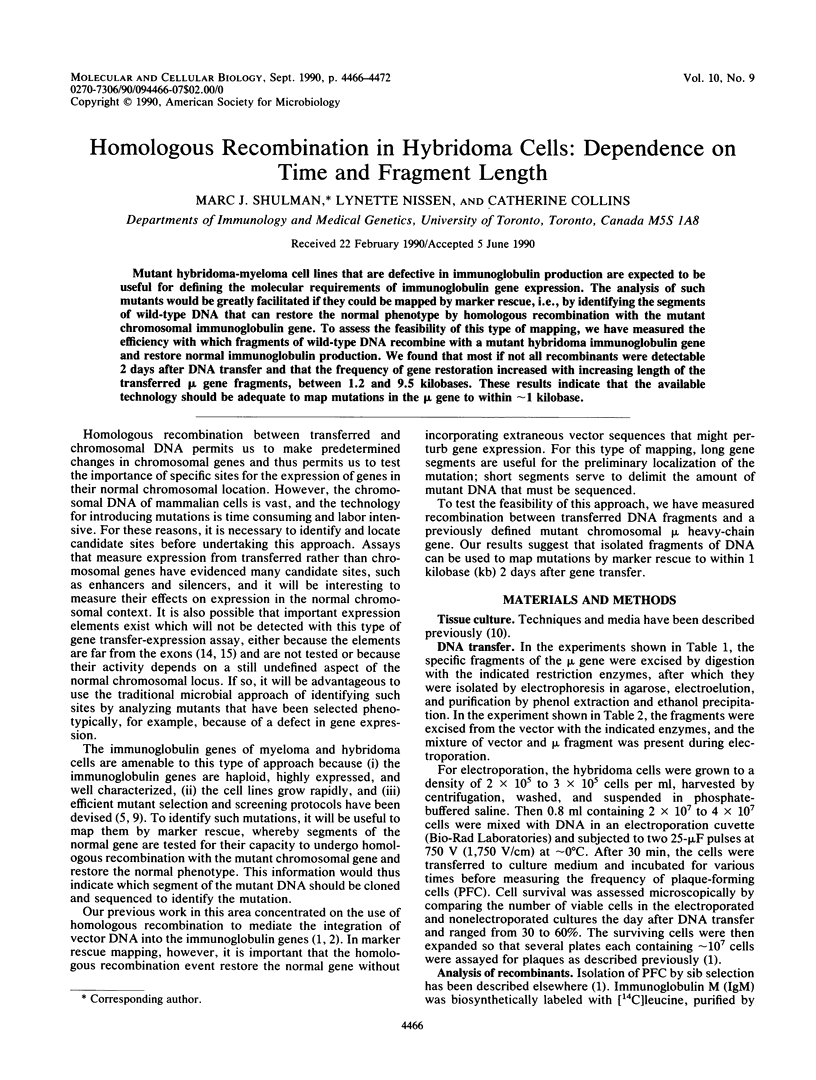
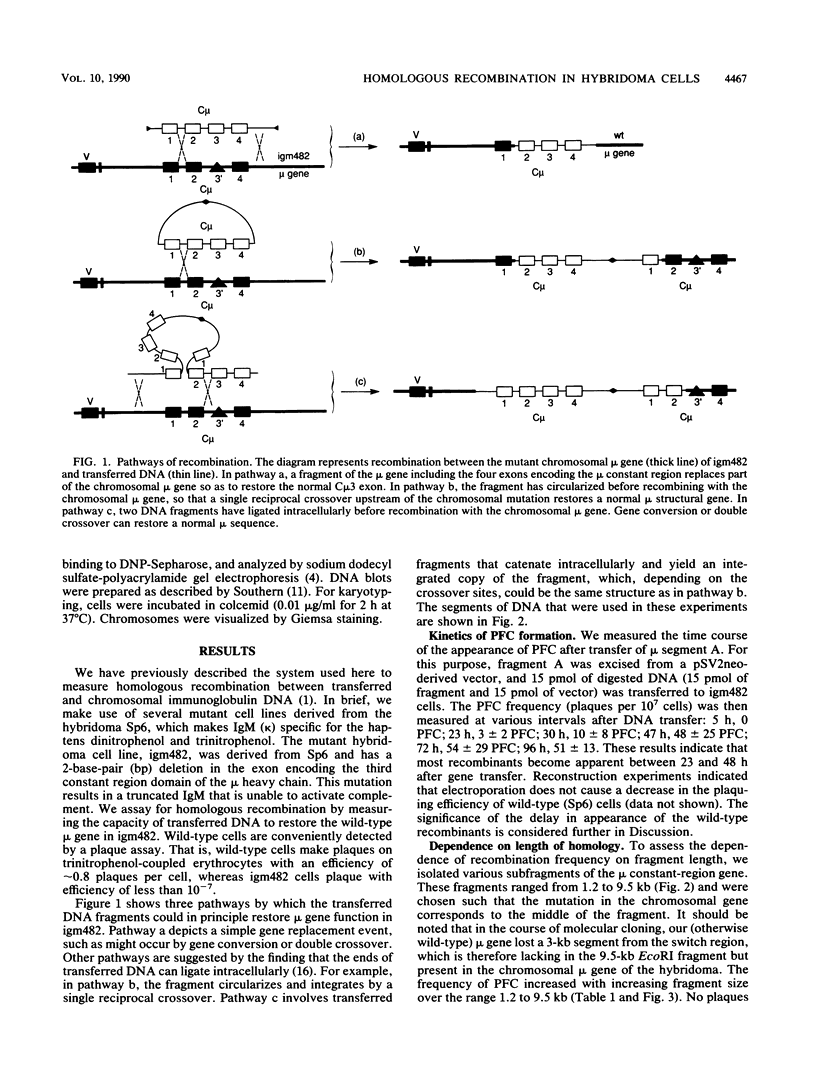
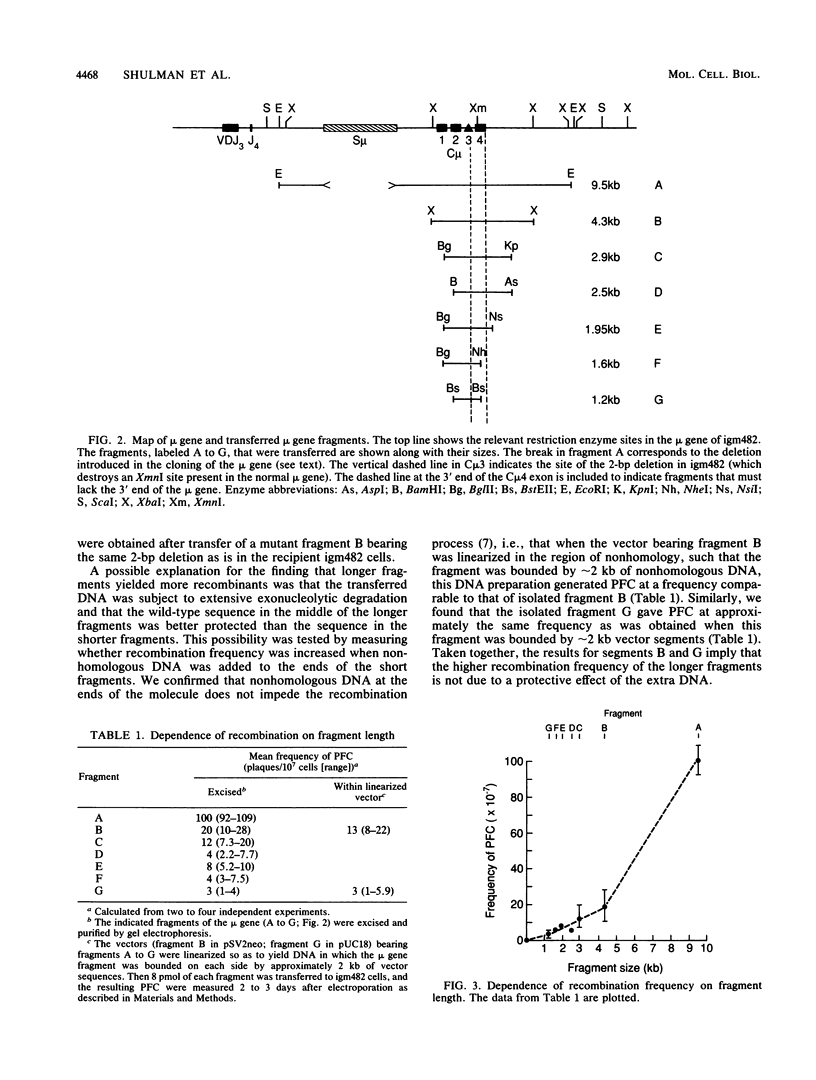
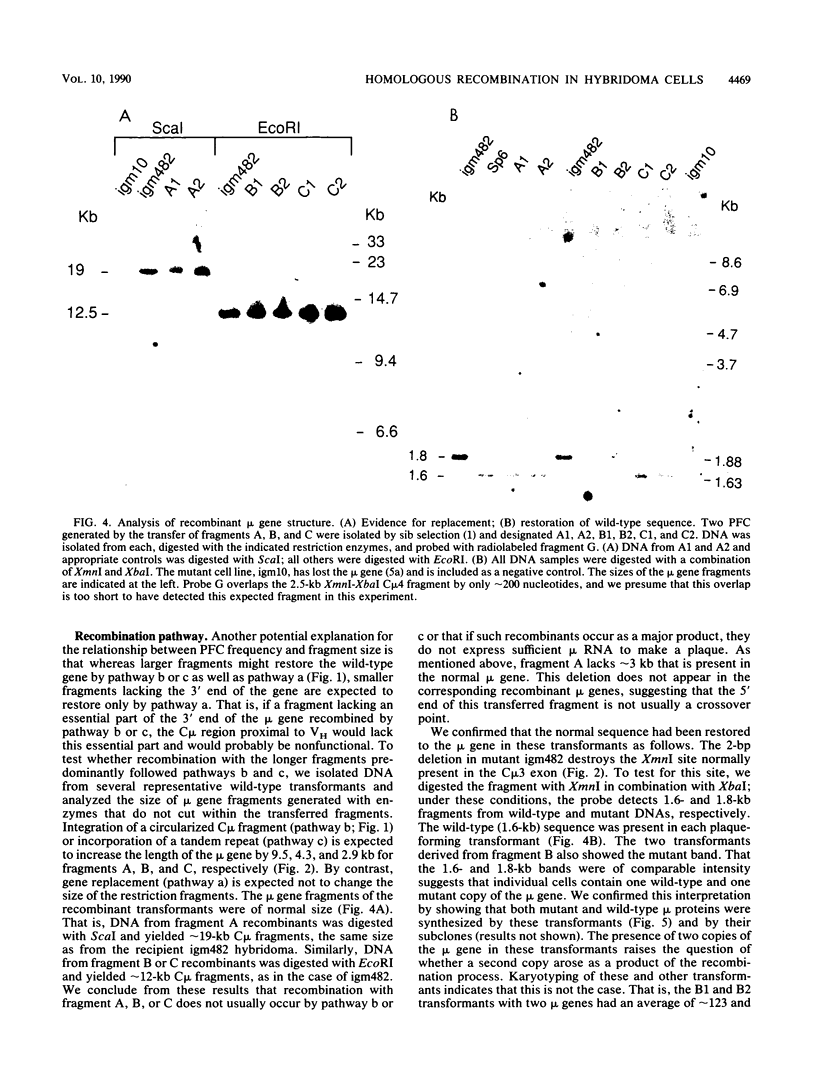
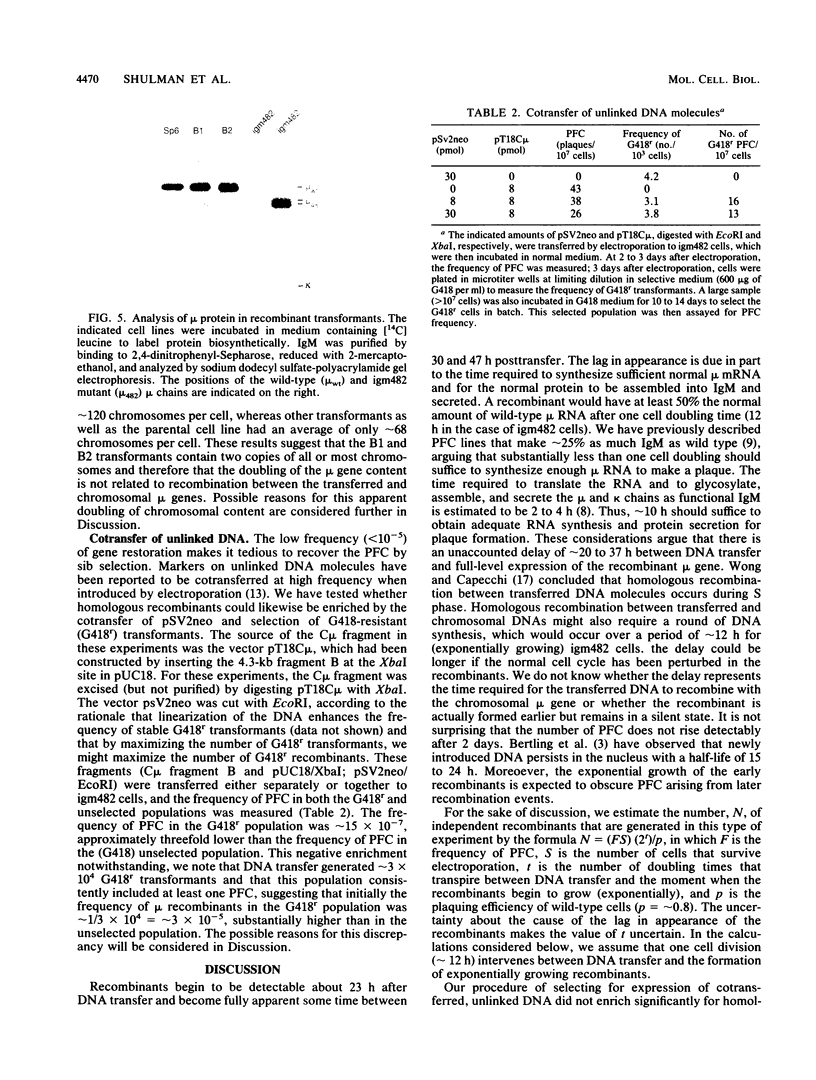
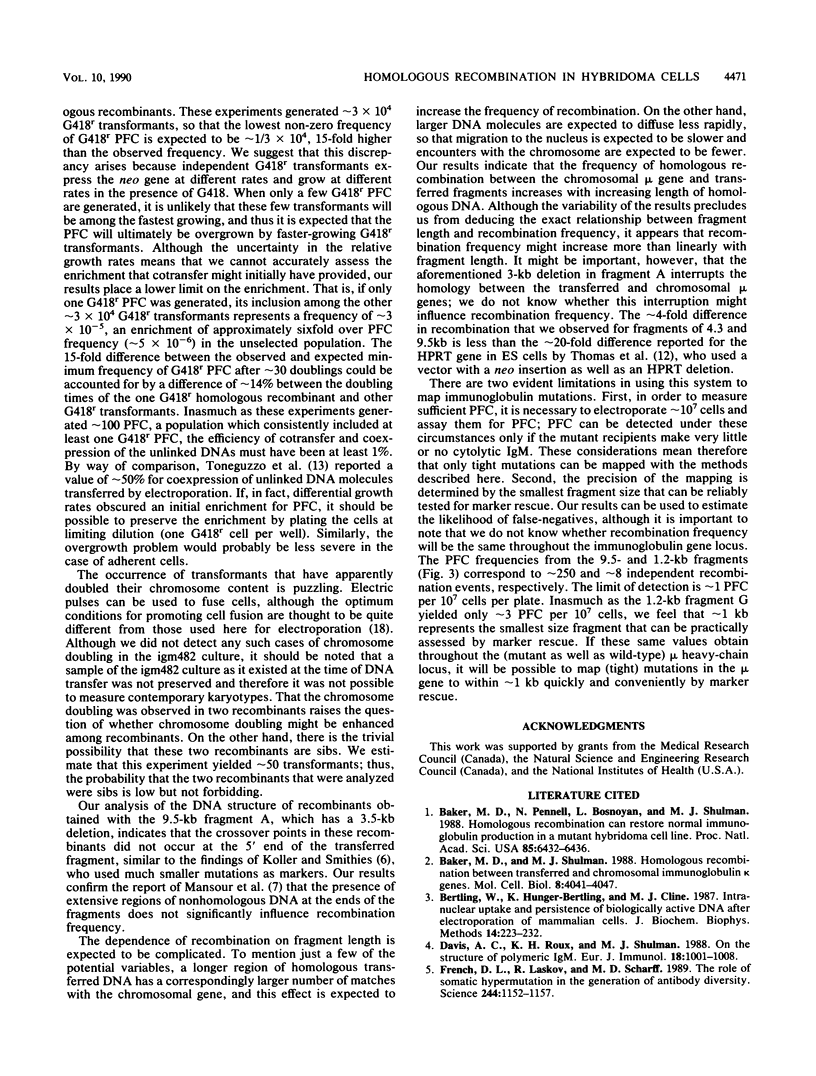
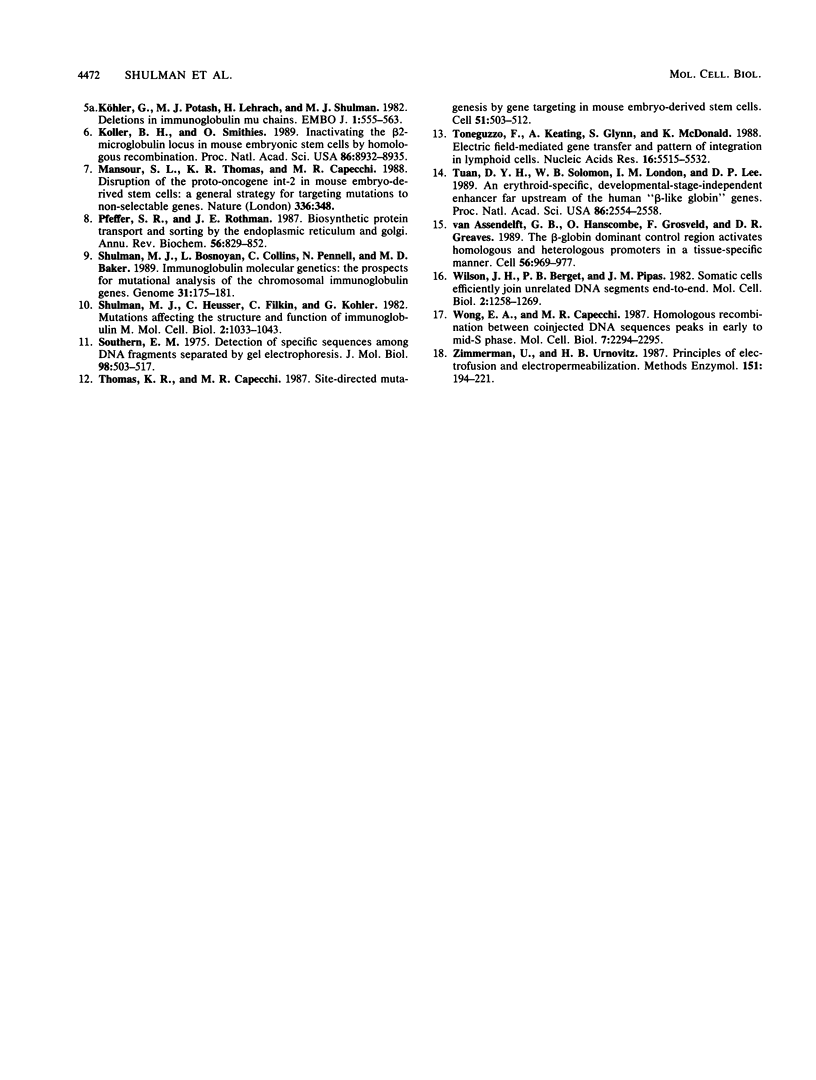
Images in this article
Selected References
These references are in PubMed. This may not be the complete list of references from this article.
- Baker M. D., Pennell N., Bosnoyan L., Shulman M. J. Homologous recombination can restore normal immunoglobulin production in a mutant hybridoma cell line. Proc Natl Acad Sci U S A. 1988 Sep;85(17):6432–6436. doi: 10.1073/pnas.85.17.6432. [DOI] [PMC free article] [PubMed] [Google Scholar]
- Baker M. D., Shulman M. J. Homologous recombination between transferred and chromosomal immunoglobulin kappa genes. Mol Cell Biol. 1988 Oct;8(10):4041–4047. doi: 10.1128/mcb.8.10.4041. [DOI] [PMC free article] [PubMed] [Google Scholar]
- Bertling W., Hunger-Bertling K., Cline M. J. Intranuclear uptake and persistence of biologically active DNA after electroporation of mammalian cells. J Biochem Biophys Methods. 1987 Jul;14(4):223–232. doi: 10.1016/0165-022x(87)90011-x. [DOI] [PubMed] [Google Scholar]
- Blom van Assendelft G., Hanscombe O., Grosveld F., Greaves D. R. The beta-globin dominant control region activates homologous and heterologous promoters in a tissue-specific manner. Cell. 1989 Mar 24;56(6):969–977. doi: 10.1016/0092-8674(89)90630-2. [DOI] [PubMed] [Google Scholar]
- Davis A. C., Roux K. H., Shulman M. J. On the structure of polymeric IgM. Eur J Immunol. 1988 Jul;18(7):1001–1008. doi: 10.1002/eji.1830180705. [DOI] [PubMed] [Google Scholar]
- French D. L., Laskov R., Scharff M. D. The role of somatic hypermutation in the generation of antibody diversity. Science. 1989 Jun 9;244(4909):1152–1157. doi: 10.1126/science.2658060. [DOI] [PubMed] [Google Scholar]
- Koller B. H., Smithies O. Inactivating the beta 2-microglobulin locus in mouse embryonic stem cells by homologous recombination. Proc Natl Acad Sci U S A. 1989 Nov;86(22):8932–8935. doi: 10.1073/pnas.86.22.8932. [DOI] [PMC free article] [PubMed] [Google Scholar]
- Köhler G., Potash M. J., Lehrach H., Shulman M. J. Deletions in immunoglobulin mu chains. EMBO J. 1982;1(5):555–563. doi: 10.1002/j.1460-2075.1982.tb01208.x. [DOI] [PMC free article] [PubMed] [Google Scholar]
- Mansour S. L., Thomas K. R., Capecchi M. R. Disruption of the proto-oncogene int-2 in mouse embryo-derived stem cells: a general strategy for targeting mutations to non-selectable genes. Nature. 1988 Nov 24;336(6197):348–352. doi: 10.1038/336348a0. [DOI] [PubMed] [Google Scholar]
- Pfeffer S. R., Rothman J. E. Biosynthetic protein transport and sorting by the endoplasmic reticulum and Golgi. Annu Rev Biochem. 1987;56:829–852. doi: 10.1146/annurev.bi.56.070187.004145. [DOI] [PubMed] [Google Scholar]
- Shulman M. J., Bosnoyan L., Collins C., Pennell N., Baker M. D. Immunoglobulin molecular genetics: the prospects for mutational analysis of the chromosomal immunoglobulin genes. Genome. 1989;31(1):175–181. doi: 10.1139/g89-030. [DOI] [PubMed] [Google Scholar]
- Shulman M. J., Heusser C., Filkin C., Köhler G. Mutations affecting the structure and function of immunoglobulin M. Mol Cell Biol. 1982 Sep;2(9):1033–1043. doi: 10.1128/mcb.2.9.1033. [DOI] [PMC free article] [PubMed] [Google Scholar]
- Southern E. M. Detection of specific sequences among DNA fragments separated by gel electrophoresis. J Mol Biol. 1975 Nov 5;98(3):503–517. doi: 10.1016/s0022-2836(75)80083-0. [DOI] [PubMed] [Google Scholar]
- Thomas K. R., Capecchi M. R. Site-directed mutagenesis by gene targeting in mouse embryo-derived stem cells. Cell. 1987 Nov 6;51(3):503–512. doi: 10.1016/0092-8674(87)90646-5. [DOI] [PubMed] [Google Scholar]
- Toneguzzo F., Keating A., Glynn S., McDonald K. Electric field-mediated gene transfer: characterization of DNA transfer and patterns of integration in lymphoid cells. Nucleic Acids Res. 1988 Jun 24;16(12):5515–5532. doi: 10.1093/nar/16.12.5515. [DOI] [PMC free article] [PubMed] [Google Scholar]
- Tuan D. Y., Solomon W. B., London I. M., Lee D. P. An erythroid-specific, developmental-stage-independent enhancer far upstream of the human "beta-like globin" genes. Proc Natl Acad Sci U S A. 1989 Apr;86(8):2554–2558. doi: 10.1073/pnas.86.8.2554. [DOI] [PMC free article] [PubMed] [Google Scholar]
- Wilson J. H., Berget P. B., Pipas J. M. Somatic cells efficiently join unrelated DNA segments end-to-end. Mol Cell Biol. 1982 Oct;2(10):1258–1269. doi: 10.1128/mcb.2.10.1258. [DOI] [PMC free article] [PubMed] [Google Scholar]
- Wong E. A., Capecchi M. R. Homologous recombination between coinjected DNA sequences peaks in early to mid-S phase. Mol Cell Biol. 1987 Jun;7(6):2294–2295. doi: 10.1128/mcb.7.6.2294. [DOI] [PMC free article] [PubMed] [Google Scholar]
- Zimmermann U., Urnovitz H. B. Principles of electrofusion and electropermeabilization. Methods Enzymol. 1987;151:194–221. doi: 10.1016/s0076-6879(87)51019-9. [DOI] [PubMed] [Google Scholar]




